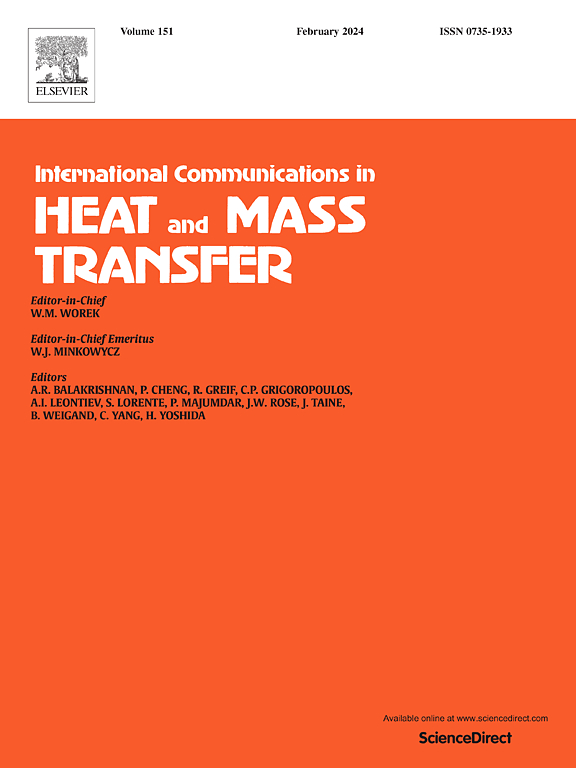The ceiling temperature characteristics in a tunnel under different fire locations
IF 6.4
2区 工程技术
Q1 MECHANICS
International Communications in Heat and Mass Transfer
Pub Date : 2025-07-02
DOI:10.1016/j.icheatmasstransfer.2025.109299
引用次数: 0
Abstract
Current studies on tunnel fires mainly focus on central-axis fires, and the combined influence of fire elevation and transverse fire location has not been explored adequately. To address this gap, a 1:8 scale experimental campaign was conducted in an 8 m × 1 m × 1 m rectangular tunnel model with variations in fire elevation and transverse fire location. The maximum ceiling temperature rise was more than twice as responsive to the fire elevation as to the transverse fire location, highlighting the dominant role of thermal radiation feedback. Accordingly, the dimensionless temperature rise reaches an upper limit of approximately 3.2, from which a linear correlation between the dimensionless maximum ceiling temperature and heat release rate was established. By accounting for transverse fire location effects, the dimensionless model describing the maximum ceiling temperature rise was refined. Furthermore, the transverse temperature attenuation was governed primarily by the transverse fire location rather than the fire elevation, with near-to-far wall differences of up to 70 K. By incorporating a double exponential summation term into the classical single exponential attenuation model, a generalized dimensionless equation was developed to accurately predict the transverse temperature profiles for various fire locations. Comparison with existing correlations and experimental data revealed a maximum relative error below 20 %, confirming the reliability and stability of the new model.
不同火灾位置下隧道顶棚温度特征分析
目前对隧道火灾的研究主要集中在中轴线火灾,对火灾高程和横向火灾位置的综合影响研究不足。为了解决这一差距,在一个8 m × 1 m × 1 m的矩形隧道模型中进行了1:8比例的实验,该模型具有不同的火灾高度和横向火灾位置。顶棚最大温升对火灾高度的响应是火灾横向位置的两倍多,突出了热辐射反馈的主导作用。因此,无因次温升达到3.2左右的上限,由此建立了无因次最高天花板温度与放热速率之间的线性关系。在考虑横向火灾位置效应的基础上,改进了描述最大顶棚温升的无因次模型。此外,横向温度衰减主要受横向火源位置而非火源高度的影响,其远近壁面差异高达70 K。在经典的单指数衰减模型中引入双指数求和项,建立了一个广义的无量纲方程,可以准确地预测不同火点的横向温度分布。与已有相关关系和实验数据的比较表明,最大相对误差在20%以下,证实了新模型的可靠性和稳定性。
本文章由计算机程序翻译,如有差异,请以英文原文为准。
求助全文
约1分钟内获得全文
求助全文
来源期刊
CiteScore
11.00
自引率
10.00%
发文量
648
审稿时长
32 days
期刊介绍:
International Communications in Heat and Mass Transfer serves as a world forum for the rapid dissemination of new ideas, new measurement techniques, preliminary findings of ongoing investigations, discussions, and criticisms in the field of heat and mass transfer. Two types of manuscript will be considered for publication: communications (short reports of new work or discussions of work which has already been published) and summaries (abstracts of reports, theses or manuscripts which are too long for publication in full). Together with its companion publication, International Journal of Heat and Mass Transfer, with which it shares the same Board of Editors, this journal is read by research workers and engineers throughout the world.

 求助内容:
求助内容: 应助结果提醒方式:
应助结果提醒方式:


